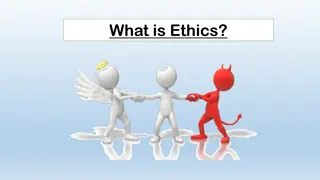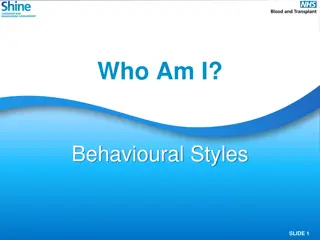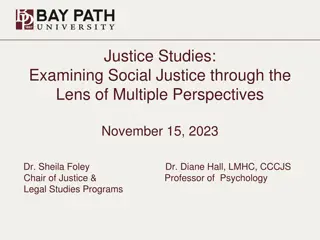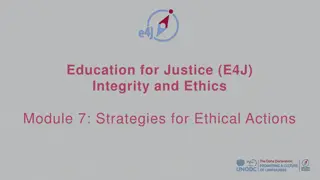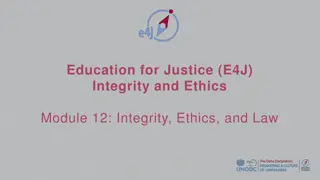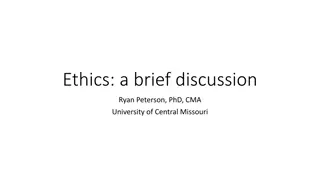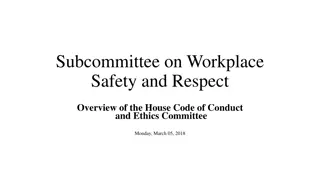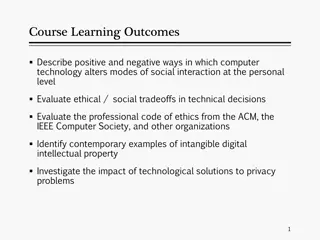Understanding and Applying Behavioural Ethics in Education for Justice (E4J)
This module focuses on debunking common myths about ethical behavior, treating ethics as a design problem, and implementing design-based solutions to encourage ethical behavior. Students will learn to identify ethical risks, turn principles into practice, and design contexts that facilitate ethical decision-making. By the end of the module, participants will appreciate the importance of behavior design in fostering ethical behavior in individuals and organizations.
Download Presentation

Please find below an Image/Link to download the presentation.
The content on the website is provided AS IS for your information and personal use only. It may not be sold, licensed, or shared on other websites without obtaining consent from the author. Download presentation by click this link. If you encounter any issues during the download, it is possible that the publisher has removed the file from their server.
E N D
Presentation Transcript
Education for Justice (E4J) Integrity and Ethics Module 8: Behavioural Ethics
Agenda Class overview (10 minutes) Four myths about morality (45 minutes) Ethics as design problem (15 minutes) Ethics, by design (25 minutes) Turning principles into practice (20 minutes) Case study: your ethical beacon (30 minutes) Designing a more ethical organization (30 minutes) Conclusion (5 minutes)
Learning Outcomes Upon completion of this module students should be able to: Recognize common misunderstandings about ethical and unethical behaviour Treat ethics as a design problem instead of a belief problem, thereby encouraging more ethical behaviour by designing contexts that increase the likelihood of ethical behaviour rather than by only trying to change the existing beliefs and principles of others Identify ethical risks in everyday life, societies, and organizations that can lead good people to do bad things Understand how to change contexts and circumstances so that people with ethical intentions can more easily follow them Appreciate design-based solutions that can be implemented effectively to increase ethical behaviour at very little financial cost
The four myths about ethical behaviour Myth 1: It s the individual: there are good people and bad people Myth 2: It s all about motives Myth 3: It s about ethical principles Myth 4: Everyone is different
Principles of behaviour design Make desired behaviour easy (remove barriers that make ethical actions harder than they need to be) Protect from risk (it is easy to underestimate ethical risks) Design to be better (no system is perfect, and one should not let perfect be the enemy of improvement)
Turning ethical principles into practice Basic steps: articulating principles (e.g. mission statements) that are memorable, actionable, and focused on unique core attributes enacting the principles by creating norms that guide action Primary problems: ethical unawareness actions guide behaviour more than articulated principles and words
Pre-class surveys Own versus others behaviour How much? Investment advisor demonstration
Ethical beacon (exercise) What was your ethical beacon? How do they lead with ethical principles? How do they enact principles in day-to-day practices (such as hiring, evaluation, compensation, or polices)? How do they respond to inevitable ethical failings?
Designing a more ethical organization What are your examples of organizations designing more ethical systems into everyday practices of hiring, promoting, rewarding, and monitoring?
Core reading Steven Pinker (2008). The moral instinct. The New York Times, 13 Jan. Available from http://www.nytimes.com/2008/01/13/magazine/13Psychology-t.html?mcubz=3 Haidt, Jonathan (2012). The Righteous Mind: Why Good People are Divided by Politics and Religion. New York: Pantheon Books. See especially Chapters 1-4 Bazerman, Max H. and Ann E. Tenbrunsel (2012). Blind Spots: Why We Fail to Do What s Right and What to Do about It. Princeton, NJ: Princeton University Press. See especially Chapters 1-4 Epley, Nicholas and David Tannenbaum (in press). Treating ethics as a design problem. Behavioral Science and Policy




